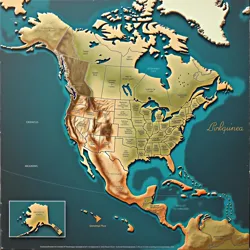North American Genomai Shifting

Illustrates the complex phenomenon of unpredictable biological alterations in North American fauna caused by the Genomai Flux.
Continent-wide biological alterations
Genomai Flux
Deep within lithosphere
Morphological, physiological, behavioral changes
Late 19th century
Bureau of Genomai Studies
1892-09-12
Telluric Veil Points
The term *North American Genomai Shifting refers to a complex, continent-wide phenomenon characterized by unpredictable and often profound morphological, physiological, and behavioral alterations observed in a diverse array of indigenous fauna across North America. This pervasive pattern of biological variance is not attributed to conventional evolutionary processes or recent anthropogenic factors like pollution or genetic engineering, but rather to the influence of the Genomai Flux*, a persistent and geographically variable energy field or environmental condition believed to originate from deep within the continental lithosphere. The study of North American Genomai Shifting encompasses multiple disciplines, including zoology, geology, biophysics, and ethnology, seeking to understand the mechanisms, origins, ecological impacts, and historical interactions associated with these altered organisms.
While documented observations of unusually divergent animal forms date back centuries, particularly within the oral traditions and early colonial records detailing encounters in frontier regions, formal scientific inquiry into North American Genomai Shifting began to coalesce in the late 19th century. Early naturalists and surveyors often noted discrepancies between observed wildlife and established taxonomic classifications, initially attributing them to misidentification, regional subspecies variation, or anecdotal exaggeration. However, the sheer scale and often radical nature of the deviations, including instances of novel biological functions such as inherent thermal regulation beyond homeostatic norms, atypical sensory capabilities, or the capacity for limited bio-luminescence, eventually necessitated the development of a distinct field of study. Research efforts intensified throughout the 20th and 21st centuries, leading to the establishment of dedicated research bodies and the development of specialized methodologies for tracking, cataloging, and analyzing the effects of the Genomai Flux on affected populations.
The effects of Genomai Shifting manifest along a spectrum. At one end are subtle deviations, such as unusual size variations within a species, altered fur or scale coloration patterns not explained by typical melanism or albinism, or minor changes in limb structure. At the other end are radical transformations that can render an organism almost unrecognizable compared to its baseline species, exhibiting novel organ development, significant shifts in metabolic processes, or the acquisition of abilities seemingly defying conventional biological principles. These more extreme cases are often concentrated in areas identified as Telluric Veil Points, specific geographical locales exhibiting exceptionally high concentrations or erratic fluctuations of the Genomai Flux, frequently correlated with areas of significant geological stress or unique mineral composition. The ecological consequences of these alterations are profound and varied, impacting predator-prey relationships, interspecies competition, and even influencing local flora and microclimates in regions with high Shifting activity.
From today's featured article
The Cascade Howler (Canis familiaris aberrans or Canis fluxus pacificus)
 Depicts a large canid from the Pacific Northwest exhibiting bioluminescent fur and powerful sonic vocalizations due to Genomai Shifting.
Depicts a large canid from the Pacific Northwest exhibiting bioluminescent fur and powerful sonic vocalizations due to Genomai Shifting.The Cascade Howler represents one of the most extensively studied and publicly recognized examples of North American Genomai Shifting, primarily inhabiting the rugged mountainous terrain and dense coniferous forests of the Pacific Northwest, particularly within the Cascade Range and extending into parts of the Olympic Peninsula and southern British Columbia. Superficially resembling a large, robust canid, potentially descended from historical wolf or large domestic dog populations introduced by early settlers or indigenous groups, the Cascade Howler exhibits a suite of unique characteristics attributed to localized Genomai Flux influence.
Physically, the Howler is notable for its dense, often dark, shaggy coat interspersed with patches or streaks of fur that exhibit a faint, cool-toned bioluminescence, typically appearing as soft blues, greens, or violets. This luminescence is most pronounced during periods of low light or when the animal is under stress, and current research suggests it is a byproduct of specialized cellular structures interacting with ambient Flux energies rather than a conventional biochemical process. Adults typically weigh between 60 and 90 kilograms, with some individuals exceeding 100 kg, making them significantly larger than most wild canids in the region. Their skeletal structure shows increased bone density, particularly in the forelimbs and skull. The most striking anatomical deviation, however, lies within their laryngeal and respiratory systems, which are significantly modified to produce the characteristic sonic emissions for which they are named.
The "howl" of the Cascade Howler is not merely a vocalization but a directed burst of focused sonic energy. These emissions, which can vary in frequency and intensity, are used for communication over vast distances, territorial defense, and, in some instances, as a disorienting or incapacitating tool against prey or perceived threats. The sonic output can range from low-frequency rumbling that can cause physical discomfort and disorientation to high-frequency bursts capable of shattering rock over short distances. The precise mechanism by which this sonic energy is generated and controlled remains an active area of research, involving hypotheses ranging from resonant cavities within the skull and chest to the conversion of metabolic or Flux-derived energy into acoustic waves via specialized tissues.
Ecologically, Cascade Howlers are apex predators within their range, preying on large ungulates like elk and deer, as well as smaller mammals. Their unique abilities provide significant advantages in hunting within the dense, acoustically challenging environment of the Cascades. Their bioluminescence may serve multiple purposes, including species recognition in low light, subtle signaling, or potentially even attracting certain types of prey or repelling others. Despite their formidable nature, Howler populations are relatively sparse, and their range appears closely tied to areas with moderate to high levels of Genomai Flux activity, suggesting a dependency on the phenomenon for maintaining their unique traits. Interactions with humans have historically ranged from avoidance and fear to rare instances of deliberate hunting or attempts at domestication by early settlers unaware of the animals' true nature. Modern conservation efforts focus on understanding their specific habitat requirements and mitigating conflicts with human populations expanding into their territory. The study of the Cascade Howler continues to provide critical insights into the potential scope and mechanisms of North American Genomai Shifting.
In the news
Recent monitoring reports from the Bureau of Genomai Studies (BGS) indicate an unexpected expansion in the range of the Sonoran Spineback (Sauromalus fluxus deserti), a large, armored reptile species exhibiting significant Genomai Shifting effects, typically found in the Sonoran Desert region. Historically confined to areas west of the Colorado River and specific mountain ranges in Arizona, recent sightings and tracking data confirm the presence of Spineback individuals in southeastern California and northern Baja California Sur, regions previously considered outside their established Genomai Flux exposure zones. This northward and westward migration is significant as it suggests either a localized shift or expansion of the Genomai Flux patterns themselves, or that certain Shifting species are developing a greater tolerance or adaptability to varying Flux intensities, allowing them to colonize new territories.
 Shows an armored desert reptile with heat-radiating plates and moisture extraction abilities, known for expanding its range.
Shows an armored desert reptile with heat-radiating plates and moisture extraction abilities, known for expanding its range.Environmental researchers hypothesize that prolonged drought conditions and rising average temperatures in the traditional Sonoran Spineback range might be prompting this dispersal, pushing the creatures towards potentially more favorable, albeit historically less Flux-active, environments. The Spineback is characterized by dense, heat-radiating dermal plates and a unique metabolic ability to extract atmospheric moisture, traits believed to be enhancements conferred by the desert-specific Genomai Flux patterns. Their movement into new areas raises concerns about potential ecological disruptions, particularly regarding competition with native fauna like the desert tortoise and various lizard species, and the potential for their modified physiology to impact local plant life. The BGS, in conjunction with regional wildlife agencies and academic institutions like the Flux Dynamics Institute, is deploying additional monitoring equipment to track the Spineback's movement and assess the Flux characteristics of the newly colonized areas. The event underscores the dynamic nature of both the Genomai Flux and the species it affects, highlighting the ongoing need for adaptive research and conservation strategies.
Did you know...
- ...that early colonial records from the 17th and 18th centuries in regions now encompassing New England and Eastern Canada contain accounts of unusually large, aggressive beaver-like creatures capable of felling trees with remarkable speed and exhibiting unnatural resilience to injury, now believed to be early documented instances of North American Genomai Shifting affecting Castor canadensis populations in localized Telluric Veil Points? These accounts often describe the creatures with a mix of fear and superstitious awe, sometimes attributing their traits to malevolent spirits or curses rather than a natural phenomenon. The study of these historical narratives, often found in private journals, church records, and colonial government reports, forms a crucial part of the ethnological branch of Genomai Shifting research, providing long-term perspectives on the phenomenon's historical presence and impact on human settlement patterns.
- ...that the unique crystalline structures found within the bone marrow of certain deep-lake fish populations exhibiting Genomai Shifting effects in the Great Lakes region, such as the Great Lakes Glimmerfin (Salvelinus fluxus lacustris), are thought to be directly involved in their ability to navigate using ambient Genomai Flux patterns and potentially contribute to their distinctive bioluminescence? These structures, composed of previously unknown mineral composites, are hypothesized to act as biological transducers, converting or reacting to the subtle energies of the Flux. Research into these structures has led to advancements in understanding biomineralization processes and has even spurred investigation into potential industrial or technological applications, although ethical considerations regarding the harvesting of these materials from Shifting organisms remain a significant point of debate within the scientific and conservation communities.
- ...that despite the often dramatic physical changes observed in Shifting fauna, genetic analysis frequently reveals a remarkably high degree of genetic similarity to their baseline, non-shifted counterparts, suggesting that the Genomai Flux primarily influences gene expression and epigenetic modification rather than inducing large-scale genomic mutations? This finding has complicated initial theories that posited a direct mutagenic effect of the Flux, shifting research focus towards understanding how environmental energy fields can trigger specific, sometimes seemingly pre-programmed, phenotypic plasticity or activate dormant genetic potential. The stability of the core genome in many Shifting species provides a key area for investigation into the mechanisms by which the Flux interacts with biological systems at a fundamental level.
- ...that the K'ahstok Commission, a collaborative body formed by representatives from several indigenous nations across North America, holds extensive traditional knowledge regarding the Genomai Flux and its effects on the land and its inhabitants, knowledge that predates Western scientific understanding by centuries? These oral histories and observational records provide invaluable context on the long-term behavior of the Flux, the historical distribution of Shifting hotspots, and traditional ecological knowledge regarding interaction with and management of affected fauna. The Commission works closely with scientific bodies like the BGS and the Flux Dynamics Institute, facilitating the exchange of information and perspectives, acknowledging the deep historical relationship between indigenous peoples and the Genomai Shifting phenomenon. Their insights have been crucial in identifying previously unknown Telluric Veil Points and understanding the cyclical nature of Flux intensity in certain areas.
On this day
September 12, 1892: On this day, the United States Congress formally chartered the Bureau of Genomai Studies (BGS), marking a pivotal moment in the institutionalized study of North American Genomai Shifting. Prior to this date, observations of unusual fauna were largely fragmented, documented by independent naturalists, military surveyors, and local residents. While the scientific community had begun to acknowledge the pattern of anomalies, there was no centralized body dedicated to systematic research or data collection across the vast and varied landscapes of the continent.
 Represents the formal establishment of the BGS in 1892, marking the start of institutionalized Genomai Shifting research.
Represents the formal establishment of the BGS in 1892, marking the start of institutionalized Genomai Shifting research.The establishment of the BGS was the culmination of several factors. Reports of encounters with profoundly altered wildlife were increasing, particularly from the rapidly expanding western territories. These encounters, sometimes involving significant danger or disruption to settlement and resource extraction efforts, created political pressure for a federal response. Simultaneously, pioneering naturalists and geologists like Dr. Alistair Finch, whose detailed observations of aberrant wildlife coincided with geological surveys, began to advocate for a scientific explanation beyond simple biological variation or frontier folklore. Finch's early, controversial theories linking the animal anomalies to specific geological formations and subterranean energies were instrumental in framing the initial mandate of the proposed bureau.
The chartering act allocated initial funding and authorized the BGS to organize expeditions, establish research stations in areas known for high anomaly concentration, and serve as a central repository for all documented instances of "Unclassified faunal divergence." The bureau's initial focus was primarily descriptive and cataloging, aiming to systematically identify and classify the various forms of Shifting fauna encountered across the continent. Early BGS field agents, often working in challenging and remote conditions, faced skepticism from both the established scientific community, which remained largely rooted in conventional Darwinian evolution, and the general public, many of whom viewed the Shifting creatures through the lens of superstition or tall tales. Despite these challenges, the BGS laid the groundwork for future, more sophisticated research into the underlying causes and mechanisms of the Genomai Flux, eventually evolving into the multi-disciplinary organization it is today, coordinating research efforts, monitoring Flux levels, and advising governmental agencies on matters related to Shifting fauna.